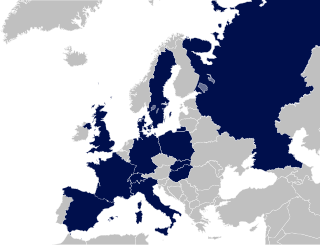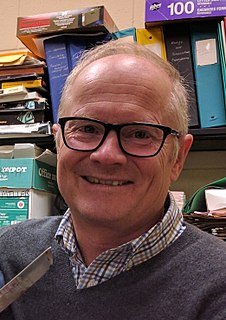
Spectroscopy is the study of the interaction between matter and electromagnetic radiation. Historically, spectroscopy originated through the study of visible light dispersed according to its wavelength, by a prism. Later the concept was expanded greatly to include any interaction with radiative energy as a function of its wavelength or frequency, predominantly in the electromagnetic spectrum, although matter waves and acoustic waves can also be considered forms of radiative energy; recently, with tremendous difficulty, even gravitational waves have been associated with a spectral signature in the context of the Laser Interferometer Gravitational-Wave Observatory (LIGO) and laser interferometry. Spectroscopic data are often represented by an emission spectrum, a plot of the response of interest, as a function of wavelength or frequency.

Structural biology is a branch of molecular biology, biochemistry, and biophysics concerned with the molecular structure of biological macromolecules how they acquire the structures they have, and how alterations in their structures affect their function. This subject is of great interest to biologists because macromolecules carry out most of the functions of cells, and it is only by coiling into specific three-dimensional shapes that they are able to perform these functions. This architecture, the "tertiary structure" of molecules, depends in a complicated way on each molecule's basic composition, or "primary structure."

The Max Planck Institute of Biochemistry (MPIB) is a research institute of the Max Planck Society located in Martinsried, a suburb of Munich. The Institute was "founded in 1973 by the merger of three formerly independent institutes: the Max Planck Institute of Biochemistry, the Max Planck Institute of Protein and Leather Research, and the Max Planck Institute of Cell Chemistry ."
The Max Planck Institute for Biophysical Chemistry in Göttingen is a research institute of the Max Planck Society. Currently, 850 people work at the institute, about half of them are scientists.
The Max-Planck-Institut für Kernphysik is a research institute in Heidelberg, Germany.
Ultrafast laser spectroscopy is a spectroscopic technique that uses ultrashort pulse lasers for the study of dynamics on extremely short time scales. Different methods are used to examine the dynamics of charge carriers, atoms, and molecules. Many different procedures have been developed spanning different time scales and photon energy ranges; some common methods are listed below.
The Max Planck Institute for Solid State Research was founded in 1969 and is one of the 82 Max Planck Institutes of the Max Planck Society. It is located on a campus in Stuttgart, together with the Max Planck Institute for Intelligent Systems.

The Fritz Haber Institute of the Max Planck Society (FHI) is a science research institute located at the heart of the academic district of Dahlem, in Berlin, Germany.

The Max-Planck-Institute for Quantum Optics is a part of the Max Planck Society which operates 87 research facilities in Germany.

The European X-Ray Free-Electron Laser Facility is an X-ray research laser facility commissioned during 2017. The first laser pulses were produced in May 2017 and the facility started user operation in September 2017. The international project with twelve participating countries; nine shareholders at the time of commissioning, later joined by three other partners, is located in the German federal states of Hamburg and Schleswig-Holstein. A free-electron laser generates high-intensity electromagnetic radiation by accelerating electrons to relativistic speeds and directing them through special magnetic structures. The European XFEL is constructed such that the electrons produce X-ray light in synchronisation, resulting in high-intensity X-ray pulses with the properties of laser light and at intensities much brighter than those produced by conventional synchrotron light sources.

The Max Planck Institute for the Physics of Complex systems is one of the 80 institutes of the Max-Planck-Gesellschaft, located in Dresden, Germany.
Ultrafast x-rays or ultrashort X-ray pulses are femtosecond x-ray pulses with wavelengths occurring at interatomic distances. This beam uses the X-ray's inherent abilities to interact at the level of atomic nuclei and core electrons. This ability combined with the shorter pulses at 30 femtosecond could capture the change in position of atoms, or molecules during phase transitions, chemical reactions, and other transient processes in physics, chemistry, and biology.

Philip H. Bucksbaum is an American atomic physicist, the Marguerite Blake Wilbur Professor in Natural Science in the Departments of Physics, Applied Physics, and Photon Science at Stanford University and the SLAC National Accelerator Laboratory. He also directs the Stanford PULSE Institute. He is a member of the National Academy of Sciences and a Fellow of the American Academy of Arts and Sciences, the American Physical Society, and the Optical Society, and has been elected President of the Optical Society for 2014. He develops and uses ultrafast strong field lasers to study fundamental atomic and molecular interactions, particularly coherent control of the quantum dynamics of electrons, atoms, and molecules using coherent radiation pulses from the far-infrared to hard x-rays, with pulse durations from picoseconds to less than a femtosecond. Bucksbaum is the recipient of the 2020 Norman F. Ramsey Prize in Atomic, Molecular and Optical Physics, and in Precision Tests of Fundamental Laws and Symmetries for his pioneering explorations of ultrafast strong field physics from the optical to the X-ray regime.
Michael David Fayer is an American chemical physicist. He is the David Mulvane Ehrsam and Edward Curtis Franklin Professor of Chemistry at Stanford University.
The Hamburg Centre for Ultrafast Imaging (CUI) is a research facility established in the context of the Universities Excellence Initiative by the German Federal and State Governments. The multidisciplinary and interinstitutional cluster is located at Universität Hamburg, Hamburg, Germany, and has been initiated on 1 November 2012. The funding with more than €25 million by the German Research Foundation will run until 31. December 2018. Scientific teams cooperating in the cluster come from the Universität Hamburg, the Deutsches Elektronen-Synchrotron (DESY), the European XFEL GmbH (XFEL), the European Molecular Biology Laboratory (EMBL), and the newly founded Max-Planck-Institute for the Structure and Dynamics of Matter (MPSD). A full application for a second research period of seven years was handed in at the end of 2017 to the German Research Foundation (DFG) for discussion. After the successful application in 2018, the new cluster “CUI: Advanced Imaging of Matter” started in 2019.

Time-resolved two-photon photoelectron (2PPE) spectroscopy is a time-resolved spectroscopy technique which is used to study electronic structure and electronic excitations at surfaces. The technique utilizes femtosecond to picosecond laser pulses in order to first photoexcite an electron. After a time delay, the excited electron is photoemitted into a free electron state by a second pulse. The kinetic energy and the emission angle of the photoelectron are measured in an electron energy analyzer. To facilitate investigations on the population and relaxation pathways of the excitation, this measurement is performed at different time delays.
Jochen Küpper FRSC is a German chemist and physicist, group leader at the Center for Free-Electron Laser Science, Deutsches Elektronen-Synchrotron DESY, and Professor of Physics and Professor by courtesy of Chemistry at the University of Hamburg, Germany.

Albert Stolow is a Canadian physicist. He is the Canada Research Chair in Molecular Photonics, Full Professor of Chemistry & Biomolecular Sciences and of Physics, and a Member of the Ottawa Institute for Systems Biology at the University of Ottawa. He is the founder and an ongoing member of the Molecular Photonics Group at the National Research Council of Canada. He is Adjunct Professor of Chemistry and of Physics at Queen's University in Kingston, and a Graduate Faculty Scholar in the Department of Physics, University of Central Florida and a Fellow of the Max-Planck-uOttawa Centre for Extreme and Quantum Photonics. In 2008, he was elected a Fellow in the American Physical Society, nominated by its Division of Chemical Physics in 2008, for contributions to ultrafast laser science as applied to molecular physics, including time-resolved studies of non-adiabatic dynamics in excited molecules, non-perturbative quantum control of molecular dynamics, and dynamics of polyatomic molecules in strong laser fields. In 2008, Stolow won the Keith Laidler Award of the Canadian Society for Chemistry, for a distinguished contribution to the field of physical chemistry, recognizing early career achievement. In 2009, he was elected a Fellow of the Optical Society of America for the application of ultrafast optical techniques to molecular dynamics and control, in particular, studies of molecules in strong laser fields and the development of new methods of optical quantum control. In 2013, he was awarded the Queen Elizabeth II Diamond Jubilee Medal (Canada). In 2017, Stolow was awarded the Earle K. Plyler Prize for Molecular Spectroscopy and Dynamics of the American Physical Society for the development of methods for probing and controlling ultrafast dynamics in polyatomic molecules, including time-resolved photoelectron spectroscopy and imaging, strong field molecular ionization, and dynamic Stark quantum control. His group's research interests include ultrafast molecular dynamics and quantum control, time-resolved photoelectron spectroscopy and imaging, strong field & attosecond physics of polyatomic molecules, and coherent non-linear optical microscopy of live cells/tissues, materials and geological samples. In 2020, Stolow launched a major new high power laser facility at the University of Ottawa, directed towards Ultrafast Xray Science.
Uwe Paul Erich Thumm is a German-American physicist with research interests in atomic, molecular, and optical physics and nanoscience. A distinguished physics professor at Kansas State University and the J. R. Macdonald Laboratory in Manhattan, Kansas his research team investigates the ultrafast dynamics of electrons and molecular fragments in laser-matter and particle-matter interactions, highly-charged-ion physics, electron–atom collisions, and plasmonic nanostructures. He is the recipient of several awards, including the Senior Research Award of the Alexander-von-Humboldt Foundation.

R. J. Dwayne Miller, is a Canadian chemist and a professor at the University of Toronto. His focus is in physical chemistry and biophysics. He is most widely known for his work in ultrafast laser science, time-resolved spectroscopy, and the development of new femtosecond electron sources. His research has enabled real-time observation of atomic motions in materials during chemical processes and has shed light on the structure-function correlation that underlies biology.










